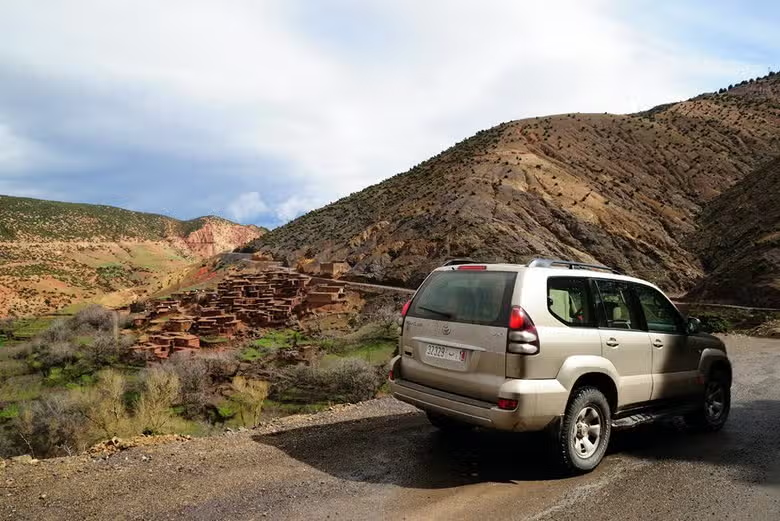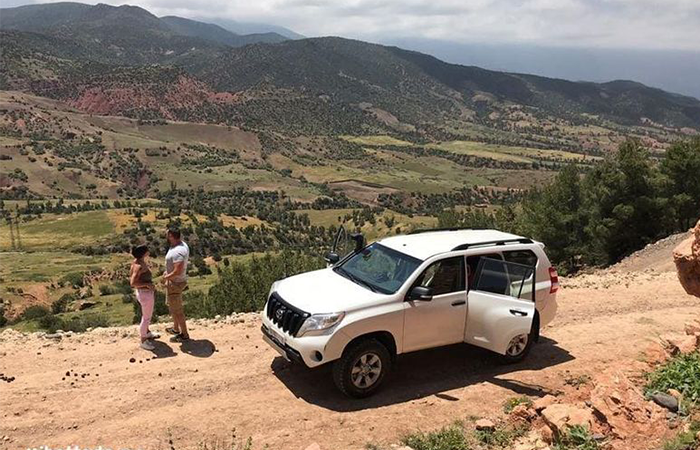Kasbah bab ourika & Berber Moroccans: A Cultural Journey
Ever wondered about diving into a world of rich culture? Kasbah Bab Ourika is your chance to see the lively culture of Berber Moroccans.
This ancient kasbah opens doors to the Berber community’s customs. For more info on your cultural trip, call +212619-958-863 or email info@caravansaharatrips.com.
Key Takeaways
- Discover the rich cultural heritage of Berber Moroccans
- Explore the historic Kasbah Bab Ourika
- Learn about the customs and traditions of the Berber community
- Plan your cultural journey with expert guides
- Experience the vibrant culture of Morocco
The Enchanting Kasbah Bab Ourika: An Overview
Kasbah Bab Ourika sits in the Ourika Valley, showing off ancient architecture. It has seen many dynasties rise and fall. Each left their mark on its walls and culture.
Location and Geographical Significance
Kasbah Bab Ourika is in the Ourika Valley, famous for its green landscapes and wildlife. Its geographical significance comes from being close to the Atlas Mountains. This made it a key spot for trade and cultural exchange.
Historical Background of the Kasbah
The historical background of Kasbah Bab Ourika is tied to the Berber people. Built in a time of great change, it was a strong home for local leaders. It shows the strength and culture of the Berbers.
Architectural Features and Design
The design of Kasbah Bab Ourika mixes Berber and Islamic styles. It has strong walls, detailed tile work, and beautiful wood decorations. Its architecture shows the skill and creativity of its builders, blending function with beauty.
The Rich Heritage of Berber Moroccans
Berber Moroccans, also known as Amazigh, have a unique cultural identity. It’s key to understanding Moroccan society. Their rich heritage shows in their history, cultural practices, and language.
Origins and History of Berber People
The Berber people have a long history that goes back to ancient times. They are the original people of North Africa, with a long presence in Morocco. Their origins are complex, shaped by many influences over the years.
Cultural Significance in Moroccan Society
The Berber community is very important in Moroccan society. They contribute to the country’s culture, social life, and economy. Their traditions and customs are a big part of Moroccan identity, influencing art, literature, and music.
Language and Communication
Berber languages, known as Tamazight, are a big part of Berber culture. These languages are spoken by millions in Morocco and are official languages. The Berber people have a rich oral tradition, with stories, poems, and songs passed down through generations.
Kasbah Bab Ourika & Berber Moroccans: A Cultural Intersection
The story of Kasbah Bab Ourika and Berber culture is both rich and complex. It’s a tale of history and ongoing cultural exchange. This blend has made the Ourika Valley a unique place.
Historical Relationship Between the Kasbah and Local Communities
The Kasbah Bab Ourika has a long history with the local Berber communities. For centuries, it was a hub of trade and commerce. Berber people from around came here, leading to a deep cultural exchange.
The Kasbah and Berber traditions influenced each other. This exchange has shaped the Kasbah and the valley’s culture.
Cultural Exchange and Preservation Efforts
The cultural exchange between Kasbah Bab Ourika and Berber communities is clear. You can see it in the architecture, art, and daily life. Efforts to keep this heritage alive include restoring the Kasbah and documenting Berber traditions.
These efforts involve local communities, historians, and preservationists working together. Their goal is to preserve the cultural heritage of the region.
| Aspect | Kasbah Bab Ourika | Berber Communities |
|---|---|---|
| Architecture | Influenced by Berber and Islamic styles | Traditional Berber homes and kasbahs |
| Cultural Practices | Blend of Berber and Moroccan customs | Rich traditions in music, dance, and crafts |
Traditional Berber Lifestyle in the Ourika Valley
The Berber community in the Ourika Valley lives a traditional lifestyle. It is deeply rooted in their history and culture. This lifestyle is characterized by a strong connection to the land, a rich cultural heritage, and a close-knit community.
Daily Life and Family Structure
Daily life in Berber communities is centered around family and community. The family structure is typically extended, with multiple generations living together. This close-knit family structure plays a crucial role in preserving cultural traditions and values.
Agricultural Practices and Sustainability
Agriculture is the backbone of the Berber economy in the Ourika Valley. The community practices sustainable farming methods, using traditional techniques passed down through generations. Crops such as olives, almonds, and walnuts are commonly grown, and the use of organic farming practices ensures the preservation of the valley’s natural beauty.
Community Gatherings and Social Customs
Community gatherings are an integral part of Berber social life. These gatherings often revolve around agricultural cycles, religious celebrations, and cultural festivals. The Berber people place a high value on hospitality, and visitors are warmly welcomed into their homes.
| Occasion | Description | Significance |
|---|---|---|
| Agricultural Festivals | Celebrations marking the beginning or end of harvest seasons. | Express gratitude for the land’s bounty and ensure future prosperity. |
| Religious Celebrations | Observance of Islamic holidays and other religious events. | Strengthen community bonds and reaffirm faith. |
| Cultural Festivals | Events showcasing Berber music, dance, and art. | Preserve cultural heritage and entertain the community. |
Berber Craftsmanship and Artistic Traditions
The artisanal traditions of the Berber people show their history and cultural strength. For centuries, Berber artisans have honed their crafts. They pass down techniques and designs to future generations.
Textiles and Carpet Weaving
Berber textiles, like carpets and blankets, are famous for their quality and beauty. These items are not just useful but also carry deep meanings.
Symbolic Patterns and Their Meanings
The patterns in Berber textiles symbolize protection, fertility, and good fortune. These symbols are key to Berber culture, showing their beliefs and values.
Traditional Weaving Techniques
Berber women weave on upright looms, using techniques passed down through generations. This process is hard, needing great skill and patience.
Pottery and Ceramics
Berber pottery is a big part of their craftsmanship. The ceramics are often decorated with traditional motifs. They are used for both everyday needs and ceremonies.
| Type of Craft | Description | Cultural Significance |
|---|---|---|
| Textiles | Woven blankets and carpets | Symbolizes protection and good fortune |
| Pottery | Ceramics decorated with traditional motifs | Used in ceremonies and daily life |
| Jewelry | Silver and metalwork adorned with symbols | Signifies status and protection |
Jewelry and Metalwork
Berber jewelry, often made from silver and decorated with symbols, is highly valued. It’s not just for show but also holds cultural significance. It can show status or offer protection.
Keeping these crafts alive is vital for Berber cultural heritage. Supporting Berber artisans and preserving their traditions is key. It helps keep these unique artistic expressions alive.
Culinary Traditions of the Berber People
The Berber people’s cooking is a mix of their history, geography, and culture. They use local ingredients and traditional ways to cook. Their dishes are full of cultural value.
Staple Foods and Ingredients
Grains like barley and wheat are staples for the Berbers. They make bread, couscous, and more from these. They also eat vegetables, fruits, and nuts from their gardens or markets.
Meat and dairy are big parts of their diet. Sheep, goats, and cattle are common animals they raise.

Traditional Cooking Methods
Slow-cooking is key in Berber cooking. It lets the flavors of the ingredients blend well. Tagine and bread making are two main examples.
Tagine Preparation
Tagine is a stew cooked in a special pot. It has meat, veggies, and dried fruits, with spices for flavor.
Bread Making Rituals
Bread making is a big deal in Berber culture. They bake it in ovens or over fires. It’s a way to bring people together.
Signature Dishes and Their Cultural Significance
Berber food is full of special dishes with deep meaning. They’re served at big events and help keep community ties strong. Traditional cooking shows respect, hospitality, and community spirit.
Music, Dance, and Celebrations in Berber Culture
The Berber culture is full of life through music, dance, and celebrations. These practices are key to who the Berbers are. They show their history, values, and community spirit.
Traditional Instruments and Musical Styles
Berber music uses special instruments like the guembri and the bendir. These instruments create lively rhythms and melodies. They are often heard at celebrations and gatherings.
Dance Forms and Their Meaning
Berber dances are varied and performed at special times. The Ahidi dance, for example, is a traditional dance. It involves complex footwork and is enjoyed by both men and women.
These dances tell stories, express emotions, and share cultural values. They are a way for the community to communicate and express themselves.
Festivals and Ceremonies Throughout the Year
The Berber calendar is packed with festivals and ceremonies. These events are often linked to farming and important life moments. The Mawlid celebration, for instance, honors the Prophet Muhammad’s birth.
These events feature music, dance, and feasting. They strengthen social bonds and celebrate cultural heritage.
Music, dance, and celebrations help the Berber people keep their culture alive. They share their rich culture with future generations. These lively expressions show the diversity and richness of Berber culture.
Experiencing Kasbah Bab Ourika Today
Kasbah Bab Ourika is a place where culture and nature meet. Visitors can explore this magical spot and learn about Berber culture and Moroccan hospitality.
Accommodation and Amenities
Kasbah Bab Ourika has many places to stay, from traditional riads to modern lodges. Guests can relax by the pool, enjoy spa treatments, or try local food at the restaurant. The kasbah aims to make your stay comfortable and unforgettable.
Cultural Immersion Experiences
There are many cultural activities to enjoy at Kasbah Bab Ourika. These activities help visitors understand Berber traditions better.
Berber Cooking Classes
Learn how to cook traditional Berber dishes. You’ll use local ingredients and old recipes.
Craft Demonstrations and Workshops
See and try your hand at Berber crafts like weaving, pottery, and jewelry making. It’s a great way to learn about Berber craftsmanship.
Traditional Music Performances
Enjoy traditional Berber music in the evenings. It’s a fun and enriching experience.
Sustainable Tourism Practices
Kasbah Bab Ourika supports sustainable tourism. It helps the local community and protects the environment. Visitors are encouraged to support local artisans and businesses to help preserve Berber culture.
| Experience | Description | Duration |
|---|---|---|
| Berber Cooking Class | Learn traditional Berber recipes | 3 hours |
| Craft Workshop | Participate in Berber craft making | 2 hours |
| Traditional Music Night | Enjoy Berber music performance | 1.5 hours |
For booking and more information, contact +212619-958-863 or email info@caravansaharatrips.com.

Exploring the Surrounding Ourika Valley
The Ourika Valley is a world of stunning natural beauty and vibrant Berber communities. It’s located in the heart of Morocco. Here, visitors find a wide range of experiences.
Natural Attractions and Landscapes
The Ourika Valley is famous for its stunning landscapes. It includes the High Atlas Mountains and lush valleys. The area has picturesque villages with fresh air and beautiful scenery.
Visitors can enjoy the calm surroundings. They can explore the local plants and admire the towering mountains.
Nearby Berber Villages
The valley is home to many Berber villages. Each village has its own culture and traditions. Visitors can dive into the local way of life by visiting these villages.
They can talk to the friendly locals and learn about their customs. This experience gives a deep look into the Berber heritage.
Hiking and Outdoor Activities
The Ourika Valley is perfect for the adventurous. It offers many hiking trails and outdoor activities. There are easy walks and challenging hikes for all levels.
The valley’s natural beauty and diverse landscapes are ideal for nature lovers and outdoor enthusiasts.
The Ourika Valley is a place where nature and culture meet. It’s a must-see for anyone visiting Morocco.
Planning Your Visit to Kasbah Bab Ourika
To experience the rich Berber culture, start by planning your visit to Kasbah Bab Ourika. This enchanting destination offers a unique blend of history, culture, and natural beauty.
Best Time to Visit
The best time to visit Kasbah Bab Ourika is during the spring (March to May) and autumn (September to November). The weather is mild and pleasant during these periods. It’s ideal for exploring the kasbah and enjoying outdoor activities.
Transportation Options
Visitors can reach Kasbah Bab Ourika by car or bus from Marrakech. The journey takes approximately one hour by car. There are also guided tours available that include transportation.
Booking Information and Contact Details
For a seamless experience, it’s advisable to book your stay and tours in advance. Here are the contact details:
Caravan Sahara Trips Services
Phone: +212619-958-863
Email and Website Contact
Email: info@caravansaharatrips.com
Online Booking Process
Visit https://caravansaharatrips.com/contact-us/ for online booking.
| Service | Contact Information |
|---|---|
| Phone | +212619-958-863 |
| info@caravansaharatrips.com | |
| Website | Booking Page |
Cultural Etiquette and Travel Tips
When visiting Kasbah Bab Ourika, respect local customs. Dress modestly and remove your shoes when entering homes or certain areas. Showing interest in the local culture and traditions is also appreciated.
Conclusion: Preserving the Legacy of Kasbah Bab Ourika and Berber Culture
Kasbah Bab Ourika and the Berber people hold a treasure trove of traditions and history. This article has shown us the rich Berber culture in the Kasbah and its valley. It has been preserved for centuries.
It’s important to keep this legacy alive for the Berber community’s unique identity. We can do this by supporting local artisans and promoting cultural experiences. Also, adopting sustainable tourism practices helps a lot.
Visitors to the Kasbah can help preserve this rich legacy. They can do this by respecting local customs and traditions. This way, future generations can enjoy this cultural heritage.
Preserving Kasbah Bab Ourika and Berber culture is a team effort. It involves local communities, authorities, and visitors. Together, we can protect this enchanting region’s cultural heritage.
FAQ
What is the significance of Kasbah Bab Ourika in Berber culture?
Kasbah Bab Ourika is a key spot in Berber culture. It has been important for their history and traditions. It’s a place where cultural exchange and preservation happen.
How can I experience Berber culture during my visit to Kasbah Bab Ourika?
You can dive into Berber culture at Kasbah Bab Ourika. Try Berber cooking classes, watch craft demonstrations, and enjoy traditional music. These activities are available for visitors.
What are the best ways to get to Kasbah Bab Ourika?
The best ways to get to Kasbah Bab Ourika are by private car or guided tours. You can book these through Caravan Sahara Trips. Call +212619-958-863 or visit their website for more information.
What is the traditional Berber lifestyle like in the Ourika Valley?
In the Ourika Valley, Berber life is all about community. Daily life centers around family, farming, and social events. It’s a mix of sustainability and cultural heritage.
Can I visit nearby Berber villages during my stay at Kasbah Bab Ourika?
Yes, you can visit nearby Berber villages. It’s a chance to see local culture and life. You can also enjoy hiking and outdoor activities in the Ourika Valley.
What are some of the traditional Berber crafts that I can expect to see?
You’ll see traditional crafts like textiles, carpet weaving, pottery, ceramics, jewelry, and metalwork. Each craft has its own meaning and shows the rich artistic side of the Berber people.
How can I book a stay or activities at Kasbah Bab Ourika?
For booking, contact Caravan Sahara Trips. Call +212619-958-863, email info@caravansaharatrips.com, or use their online booking. They’ll help you plan your visit.



